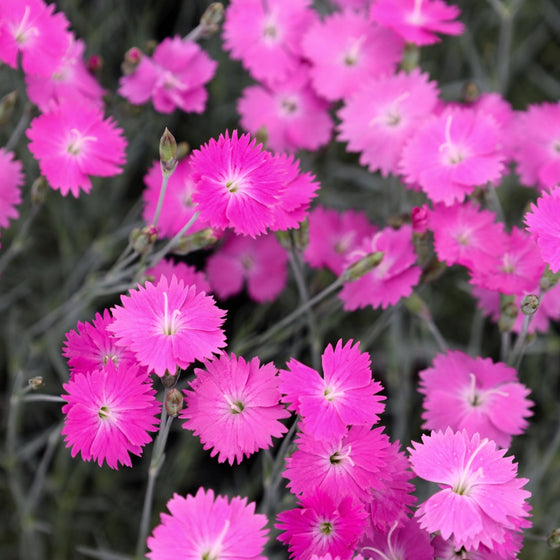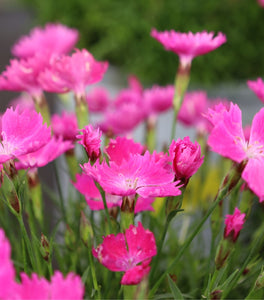
Images Depict Mature Plants
Dianthus Firewitch Plants
Dianthus 'Firewitch', also known as Cheddar Pink, is a standout perennial prized for its fragrant, magenta-pink blooms and evergreen, silver-blue foliage. Blooming profusely from late spring into early summer, and often reblooming with light deadheading, this low-growing, clump-forming plant creates a vibrant carpet of color. Each flower emits a spicy clove-like scent that makes Firewitch Dianthus as enjoyable to smell as it is to see, attracting butterflies and other beneficial pollinators to your garden.
Growing just 6 to 8 inches tall with a spread of about 12 inches, Firewitch Dianthus is perfect for borders, rock gardens, cottage gardens, and edging. It thrives in full sun and well-drained soil, and is notably drought tolerant once established, making it an excellent choice for low-maintenance and xeriscape landscapes. Its tidy mounding habit and showy flowers also make it a great addition to container plantings where texture, fragrance, and color are desired.
In addition to its striking visual appeal, Dianthus Firewitch is also deer resistant and tolerant of poor, sandy soils, giving it high performance value in tough garden spots. Use it to brighten pathways, soften the edges of hardscapes, or weave through mixed perennial beds for a pop of long-lasting color. This award-winning perennial offers both ornamental beauty and ease of care, making it a top choice for gardeners of all experience levels.
2005 Perennial Plant of the Year

| Hardiness Zone: | 3-9 |
|---|---|
| Mature Height: | 8 to 12 Inches |
| Mature Width: | 6 to 18 inches |
| Sunlight: | Full |
| Water Requirements: | Water well only until established |
| Flower Color: | Fuschia Pink |
| Details: | Fragrant flowers, attracts butterflies |
How to Care for Dianthus Firewitch
Be sure to read our planting instructions to ensure a healthy and happy Dianthus Firewitch plant for years to come!
How Do I Plant A Dianthus Firewitch Plant?
Planting a Dianthus Firewitch plant starts with selecting the right location—these hardy perennials thrive in full sun and well-drained soil, making them ideal for rock gardens, sunny borders, and cottage-style landscapes. Begin by loosening the soil and amending it with compost or coarse sand if needed to improve drainage, as Dianthus dislikes wet or soggy conditions. Dig a hole just slightly larger than the root ball, and place the plant so that the crown is level with the soil surface. Fill in the hole, gently firm the soil, and water thoroughly to help the roots settle in. Space Firewitch Dianthus plants about 10 to 12 inches apart to allow for airflow and to accommodate their natural spreading habit. Adding a thin layer of mulch around the base will help suppress weeds and retain moisture, but avoid covering the crown to prevent rot. Once established, Dianthus Firewitch forms a dense, low-growing mat of silver-blue foliage topped with bright magenta-pink blooms in late spring. This easy-care perennial will quickly become a reliable staple in your landscape, offering color, fragrance, and texture season after season.
How Do I Water A Dianthus Firewitch Plant?
Watering your Dianthus Firewitch plant properly is key to establishing strong roots and maintaining healthy blooms. After planting, keep the soil evenly moist during the first few weeks to help the roots settle in, but be careful not to overwater—Dianthus prefers well-drained soil and is susceptible to root rot in soggy conditions. Once established, this perennial becomes moderately drought tolerant, making it a smart choice for low-maintenance and xeriscape gardens. During the growing season, water only when the top inch of soil feels dry, typically once a week in normal conditions, and more often during extreme heat or in containers. Always water at the base of the plant rather than overhead to help prevent fungal diseases on the foliage. For potted Firewitch Dianthus, check moisture levels more frequently, as containers dry out faster than garden soil. By maintaining a consistent but moderate watering routine, your Dianthus Firewitch will thrive with vibrant blooms and compact, silvery-blue foliage throughout the season.
How Do I Fertilize A Dianthus Firewitch Plant?
Fertilizing your Dianthus Firewitch plant correctly will enhance its flowering and overall health without encouraging excessive foliage growth. In early spring, as new growth begins to emerge, apply a balanced, slow-release fertilizer such as a 10-10-10 formula around the base of the plant. Be careful not to let the fertilizer touch the stems or crown, as this can cause burning. This single spring feeding is often enough to support the plant throughout its blooming period, especially in nutrient-rich or amended garden soil. For poor or sandy soils, you may opt to apply a light dose of liquid fertilizer once a month during the growing season to encourage continuous blooming and vibrant foliage. Avoid over-fertilizing, as too much nitrogen can lead to soft, leggy growth and fewer flowers. Always water after fertilizing to help nutrients penetrate the root zone. With the right fertilization strategy, your Firewitch Dianthus will reward you with a flush of fragrant magenta-pink blooms and tidy, evergreen silver-blue foliage—perfect for borders, rock gardens, and containers.

How and When Should I Prune Dianthus Firewitch Plants?
Pruning Dianthus Firewitch plants helps maintain their compact shape, encourages reblooming, and keeps the foliage tidy throughout the growing season. After the first flush of fragrant magenta-pink blooms fades in late spring or early summer, lightly deadhead spent flowers by cutting the flower stems down to the base of the foliage. This will encourage the plant to produce additional blooms and prolong the flowering period. Use clean, sharp garden scissors or pruners to prevent tearing the stems and to reduce the risk of disease. In the fall, once the plant has finished blooming and the weather begins to cool, perform a light cleanup by trimming back any yellowed or damaged leaves. However, avoid cutting back the plant too aggressively—Dianthus Firewitch is evergreen in many regions, and its silvery-blue foliage adds winter interest. If needed, a more thorough rejuvenation pruning can be done in early spring before new growth begins. With proper pruning, your Firewitch Dianthus will maintain a neat appearance and provide reliable color, fragrance, and form year after year in borders, rock gardens, and containers.

















